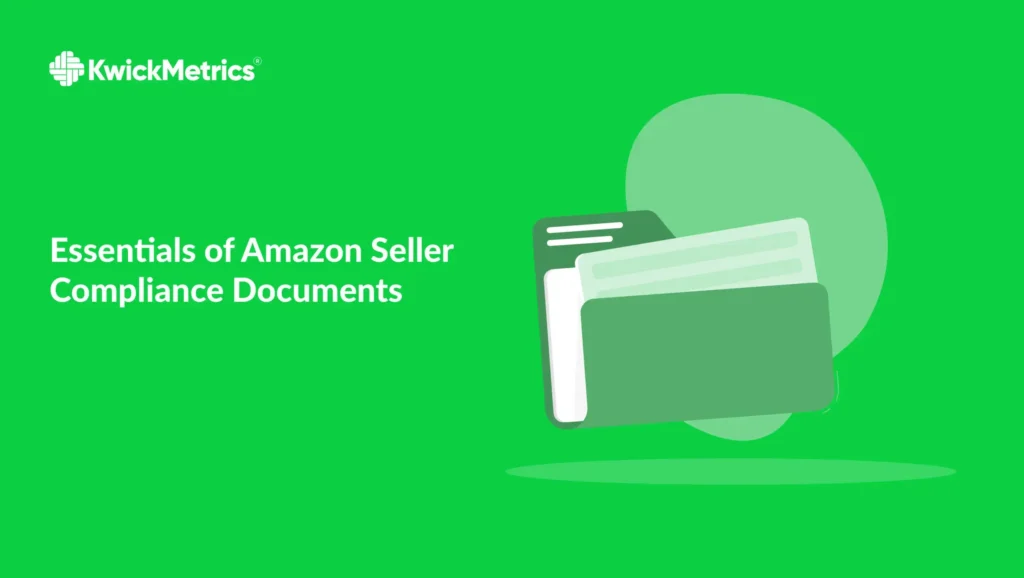Essentials of Amazon Compliance Documents

Table of Contents
- What Are Amazon Compliance Documents and Their Significance?
- KwickMetrics - The Business Intelligence and Analytics Tool
- Examples of Amazon-approved compliance documents include
- Why Upload Compliance Documents?
- How to Navigate the Compliance Dashboard?
- Are Amazon Compliance Documents Essential for Product Safety?
- Explore Our Features!
- FAQs In relation to Amazon Compliance Document
- Conclusion
In the vast and dynamic world of e-commerce, compliance with legal, regulatory, and platform-specific standards is crucial for the success and sustainability of an online business. For sellers on Amazon, ensuring that their products meet the necessary safety and regulatory requirements is of paramount importance. This comprehensive guide aims to shed light on Amazon compliance documents, the types of products that require them, the upload process, and how sellers can navigate and address compliance issues effectively.
What Are Amazon Compliance Documents and Their Significance?
Amazon has instituted a policy requiring sellers to submit compliance documents to prove that their products meet safety and regulatory standards. These documents serve as evidence that the items are safe for public use and adhere to international, federal, state, and local laws. Sellers typically upload these documents during the initial product listing, but Amazon may request additional documentation at any time, especially in response to customer complaints, regulatory changes, or internal audits.
KwickMetrics - The Business Intelligence and Analytics Tool
Explore 14-day free trial! No credit card required, cancel at any time.
Examples of Amazon-approved compliance documents include
-
- Safety certificates
- Test reports
- Label images
- Safety manuals
- Tracking labels
- Registration cards
- Compliance markings
It’s essential to note that specific industries may require unique documents. For instance, children’s products necessitate a Children’s Product Certificate (CPC). Failure to comply with these regulations can result in the removal of product listings and even the blocking of a seller’s store.
Why Upload Compliance Documents?
Not every seller is required to submit compliance documents. The obligation arises for products falling under international, federal, state, and local regulations. Additionally, Amazon has its own set of restricted product categories, each with its unique compliance requirements. Sellers must prove compliance for items falling within these restricted categories.
1. Legal Regulations
Certain industries face heightened scrutiny due to the nature of their products. Examples include pesticide manufacturers, motor vehicles, electronics, and children’s products. The USA, for instance, enforces strict regulations, such as the Toxic Substances Control Act (TSCA), restricting the use of specific chemicals.
Moreover, states like California may have more stringent standards, as seen in the California Air Resource Board (CARB) regulations on volatile organic compounds (VOCs). Sellers must navigate these complex regulations to ensure their products meet the necessary standards.
Key Takeaway:
Navigating complex regulations is crucial for product compliance, ensuring alignment with international, federal, and state standards.
2. Amazon Restricted Products
Amazon maintains a list of restricted products, some outright prohibited and others requiring documentation for approval.
Amazon Restricted Products: Detailed list
- Supplements
- Certain Food Items
- Any Environmental Product
- Products Made for Children and Animals
- Alcohol
- Fine Art
- Disinfectants
- Cosmetics and Skincare/Haircare
- Weapons
- Burial Artifacts
- Lasers
- Precious Gems
- Theft Devices
- Lighting
- Medical Devices
- Seeds and Plants
- Postage Stamps
- Surveillance Equipment
- Tobacco
- Upholstery
Sellers intending to list such items must upload the required documents and seek approval before making them available on Amazon. Compliance documents act as a gateway to selling within these restricted categories.
Key Takeaway:
Sellers must prove compliance for items falling within Amazon's restricted product categories.
How to Navigate the Compliance Dashboard?
To streamline the compliance process, Amazon provides sellers with a dedicated platform – the Manage Your Compliance dashboard. Here, sellers can upload, manage, and respond to compliance documents, as well as address any regulatory requirements. To access the dashboard:
- Go to your Amazon Seller Central account.
- Open the menu and navigate to Performance > Account Health > Product Compliance Requests.
On the dashboard, sellers can view product details, Amazon compliance requirements, and approval statuses. This information includes the date of document upload, sales data for the past 60 days, and any products requiring documentation.
Key Takeaway:
Efficient use of the Compliance Dashboard is essential for staying informed, managing documents, and promptly addressing compliance issues.
Uploading Documents
If a seller’s products require safety documents, a warning sign on the dashboard prompts action. Sellers can click the provided link to upload compliance documents, choosing between single or bulk uploads. For multiple products, a spreadsheet with product names, ASINs, and compliance details can be submitted.
The dashboard is not merely a place for document uploads but also serves as a resource for staying informed about changing regulations, addressing import/export issues, and understanding safety concerns in specific industries.
Additional Services on Manage Your Compliance
The Manage Your Compliance dashboard offers more than document uploads. It serves as a valuable resource for sellers facing various challenges, such as international order issues and industry-specific safety concerns. The reference section assists sellers in finding providers to help meet regulatory requirements, though sellers must verify the provided references’ accuracy and currency.
Identifying Amazon Compliance Violations
Amazon notifies sellers of compliance violations through the Manage Your Compliance dashboard. A warning is displayed, accompanied by a general account health rating. Sellers dealing with restricted products should regularly check this section to ensure compliance and address any issues promptly.
Addressing Compliance Issues
When a violation is identified, Amazon provides instructions to rectify the compliance issue. The general process involves:
-
- Reviewing the violation details.
- Writing an appeal letter and gathering necessary compliance documents.
- Submitting a Plan of Action if required.
- Uploading all documents within the specified deadline (typically 48 hours).
- Allowing up to seven days for a formal resolution. If no response is received, documents may need to be resubmitted.
Resolved violations are reflected in the account health dashboard.
Are Amazon Compliance Documents Essential for Product Safety?
Given the evolving nature of regulations, it’s challenging for sellers to stay abreast of every compliance law or regulatory change. However, Amazon’s notification system helps sellers stay informed of any compliance issues, providing an opportunity to rectify them before facing severe consequences.
Explore Our Features!
FAQs In relation to Amazon Compliance Document
Are compliance documents mandatory for every Amazon seller?
No, not every seller needs to submit compliance documents. Requirements depend on the nature of products and Amazon’s restricted categories.
How often should sellers check the Manage Your Compliance dashboard?
Sellers dealing with restricted products should regularly check the dashboard to ensure compliance. Regular monitoring helps address issues promptly.
What happens if a seller receives a compliance violation notice?
Sellers must review violation details, write an appeal letter, gather necessary documents, and submit a Plan of Action within the specified deadline.
Do sellers need to navigate complex state regulations for compliance?
Yes, certain industries, like electronics or children’s products, may face state-specific regulations. Sellers must navigate these regulations to ensure compliance.
Can compliance documents be uploaded in bulk on Amazon?
Yes, sellers can choose between single or bulk uploads for compliance documents. A spreadsheet with product details can be submitted for multiple products.
Conclusion
Ensuring compliance with Amazon’s standards and regulations is a continuous effort for sellers. By understanding the types of products that require compliance documents, using the Manage Your Compliance dashboard efficiently, and promptly addressing violations, sellers can navigate the complexities of Amazon’s compliance requirements. Staying informed about changing regulations and seeking assistance when needed are crucial steps in maintaining a successful and compliant presence on the e-commerce giant.



